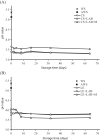Preservation of Ceriporiopsis subvermispora and Lentinula edodes treated wheat straw under anaerobic conditions
- PMID: 29030967
- PMCID: PMC5846887
- DOI: 10.1002/jsfa.8745
Preservation of Ceriporiopsis subvermispora and Lentinula edodes treated wheat straw under anaerobic conditions
Abstract
Background: No attention has been paid so far to the preservation of fungal-treated lignocellulose for longer periods. In the present study, we treated wheat straw (WS) with the white-rot fungi Ceriporiopsis subvermispora and Lentinula edodes for 8 weeks and assessed changes in pH, chemical composition and in vitro gas production (IVGP) weekly. Fungal-treated WS was also stored for 64 days 'as is', with the addition of lactic acid bacteria (LAB) or with a combination of LAB and molasses in airtight glass jars mimicking ensiling conditions.
Results: Both fungi significantly reduced the lignin and hemicellulose content of WS, and increased the cellulose content. The IVGP increased with increasing time of incubation, indicating the increase in digestibility. Both fungi lowered the pH of WS under 4.3, which guarantees an initial and stable low pH during anaerobic storage. Minor changes in fibre composition and IVGP were observed for stored L. edodes treated WS, whereas no change occurred for C. subvermispora.
Conclusion: It is possible to conserve C. subvermispora and L. edodes treated straw under anaerobic condition without additives up to 64 days. This finding is important for practical application to supply fungi-treated feed to ruminant animals for a prolonged period. © 2017 The Authors. Journal of The Science of Food and Agriculture published by John Wiley & Sons Ltd on behalf of Society of Chemical Industry.
Keywords: Ceriporiopsis subvermispora; Lentinula edodes; anaerobic storage; in vitro gas production; wheat straw.
© 2017 The Authors. Journal of The Science of Food and Agriculture published by John Wiley & Sons Ltd on behalf of Society of Chemical Industry.
Figures




Similar articles
-
Improving ruminal digestibility of various wheat straw types by white-rot fungi.J Sci Food Agric. 2019 Jan 30;99(2):957-965. doi: 10.1002/jsfa.9320. Epub 2018 Oct 16. J Sci Food Agric. 2019. PMID: 30125969 Free PMC article.
-
Differences between two strains of Ceriporiopsis subvermispora on improving the nutritive value of wheat straw for ruminants.J Appl Microbiol. 2017 Aug;123(2):352-361. doi: 10.1111/jam.13494. Epub 2017 Jul 13. J Appl Microbiol. 2017. PMID: 28517113
-
Screening of white-rot fungi for bioprocessing of wheat straw into ruminant feed.J Appl Microbiol. 2018 Aug;125(2):468-479. doi: 10.1111/jam.13894. Epub 2018 May 23. J Appl Microbiol. 2018. PMID: 29704882
-
Fungal treated lignocellulosic biomass as ruminant feed ingredient: a review.Biotechnol Adv. 2015 Jan-Feb;33(1):191-202. doi: 10.1016/j.biotechadv.2014.10.014. Epub 2014 Nov 8. Biotechnol Adv. 2015. PMID: 25447421 Review.
-
Nutraceutical and functional scenario of wheat straw.Crit Rev Food Sci Nutr. 2013;53(3):287-95. doi: 10.1080/10408398.2010.528080. Crit Rev Food Sci Nutr. 2013. PMID: 23216000 Review.
Cited by
-
Effects of mixed agro-residues (corn crop waste) on lignin-degrading enzyme activities, growth, and quality of Lentinula edodes.RSC Adv. 2020 Mar 6;10(17):9798-9807. doi: 10.1039/c9ra10405d. eCollection 2020 Mar 6. RSC Adv. 2020. PMID: 35498574 Free PMC article.
-
Enhanced lignin degradation by Irpex lacteus through expanded sterilization further improved the fermentation quality and microbial community during the silage preservation process.Bioresour Bioprocess. 2024 Jan 22;11(1):14. doi: 10.1186/s40643-024-00730-2. Bioresour Bioprocess. 2024. PMID: 38647879 Free PMC article.
-
Conversion of Lignocellulosic Biomass Into Valuable Feed for Ruminants Using White Rot Fungi.J Anim Physiol Anim Nutr (Berl). 2025 May;109(3):800-811. doi: 10.1111/jpn.14099. Epub 2025 Jan 10. J Anim Physiol Anim Nutr (Berl). 2025. PMID: 39797406 Free PMC article.
-
Enhancing Agricultural Sustainability by Improving the Efficiency of Lignocellulosic Biomass Utilization in the Ruminant Diet via Solid-State Fermentation with White-Rot Fungi: A Review.Microorganisms. 2025 Jul 21;13(7):1708. doi: 10.3390/microorganisms13071708. Microorganisms. 2025. PMID: 40732216 Free PMC article. Review.
References
-
- Prasad S, Singh A and Joshi HC, Ethanol as an alternative fuel from agricultural, industrial and urban residues. Resour Conserv Recyc 50:1–39 (2007).
-
- Sarkar N, Ghosh SK, Bannerjee S and Aikat K, Bioethanol production from agricultural wastes: an overview. Renew Energy 37:19–27 (2012).
-
- Buranov AU and Mazza G, Lignin in straw of herbaceous crops. Ind Crop Prod 28:237–259 (2008).
-
- Jung HG and Vogel KP, Influence of lignin on digestibility of forage cell wall material. J Anim Sci 62:1703–1712 (1986). - PubMed
-
- Sarnklong C, Cone JW, Pellikaan W and Hendriks WH, Utilization of rice straw and different treatments to improve its feed value for ruminants: a review. Asian‐Aust J Anim Sci 23:680 (2010).
MeSH terms
Substances
LinkOut - more resources
Full Text Sources
Other Literature Sources
Miscellaneous

